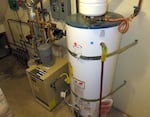State lawmakers are considering a bill that would save Oregonians money on their utility bills by requiring home appliances to be more energy efficient.
House Bill 2062 would increase energy efficiency standards for things like dishwashers, water heaters, refrigerators, televisions and lamps in an effort to reduce greenhouse gas emissions that contribute to climate change.
The Oregon Department of Energy created the bill in response to Gov. Kate Brown’s executive order on climate change, which calls for raising Oregon’s appliance standards to match Washington and California.
“So basically, the governor wanted to make sure that we’re keeping up with our neighbors,” Oregon Department of Energy Director Janine Benner said. “Appliance standards are increasingly important as buildings get more efficient, but an increasing share of energy consumption goes to the products and appliances that are plugged in. And those aren’t included in building codes.”

Gov. Kate Brown's executive order on climate change calls for increasing energy efficiency standards for home appliances such as hot water heaters.
Tom Banse
A Department of Energy analysis found updating appliance standards would cut 76,000 metric tons of carbon dioxide and save Oregonians $35 million on their utility bills by reducing the amount of electricity and natural gas gets used by home appliances.
“How energy is generated and used in the state really does have a big impact on climate change,” Benner said. “About 80% of greenhouse gas emissions in the state come from daily energy use: Turning on our lights, heating our homes and businesses and driving around.”
Brad Reed with the clean energy advocacy group Renew Oregon said the bill has broad support and is already making its way through legislative committees.
“It’s sort of catching us up,” he said. “It’s going to save Oregonians money. It’s going to reduce pollution. Really, it’s a win-win.”
Reed said the appliance efficiency standards requirement is “a bright spot” in the governor’s executive order on climate change, which also includes a directive to create a cap and reduce program that would help lower greenhouse gas emissions statewide to the state’s goal of 45% below 1990 levels by 2035 and at least 80% below 1990 levels by 2050.
The Oregon Department of Environmental Quality is developing that program with guidance from a rulemaking advisory committee that is meeting regularly to discuss how it should work. Reed said the program is another piece of Brown’s executive order that has a lot of potential to reduce emissions.
“The executive order is sweeping climate action for Oregon that will, if it lives up to its ambition, will help us tremendously to transform to a clean energy economy,” he said. “There are several different programs that will make a really big difference like updating our building codes and extending the clean fuels program, but the cap and reduce program is one that can guide all of the sectors, industrial, oil companies, power plants and all the biggest emission sources ramping down toward zero emissions.”
If the new appliance standards bill passes this session, the new rules would kick in later this year. The cap and reduce program, also known as the Climate Protection Program, is scheduled to launch in 2022.
